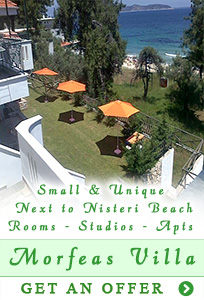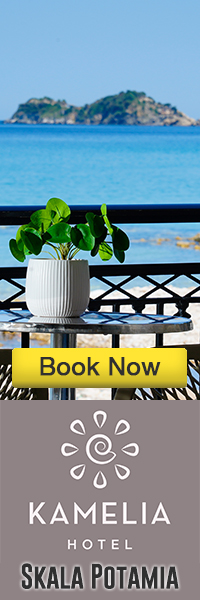Museums
Dive Into the Past and Present

Immerse yourself with the history and culture of Thassos' ancient and recent past by visiting the many museums around the island. See interesting antiquities and impressive artefacts, touch traditional tools, and learn all about the islanders' interesting, simplistic, and laid-back way of life.
A special gem of our island is the archaeological museum, located in the capital, Limenas. It boasts amazing displays of ancient findings from the area and the whole island, with an incredibly passionate team of staff who enjoy sharing their knowledge and passion with visitors.
The majority of museums on Thassos are of culture and folklore, providing interesting insight on the every day life of Thassian residents of the past. There are also museums of agriculture, where you can learn about the island's vital olive oil and honey industries as well as traditional and modern methods of production.
History Museums
Archaeological Museum
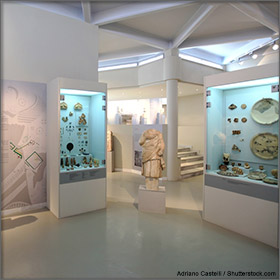
Having been recently renovated since its construction in 1934, the museum proudly stands at the centre of the capital Limenas attracting thousands of visitors from Greece and beyond. The archaeological museum of Thassos mirrors the ancient civilization of the area. It houses vast collections of unique wealth from the 7th century BC up through the 7th century AD
At the entrance of the museum, stands a 3.5 metre high statue of Kouros, one of the earliest types of Hellenic sculpture. The Kouros is presumed to date back to the 6th century BC and was made for the altar of Apollo. It exhibits its creator, or even Apollo himself, holding a ram. The man is naked, standing in a priest-like position, showing his left leg without bending it. The hair is tied with a ribbon and it forms a pattern that falls heavily like a wig. Its hair appears to be the last element on which the sculptor was working before leaving the statue incomplete, abandoning it after the marble cracked from the left ear towards the back of the head, which can still be seen today. The sheer size of this statue makes it one of the best exhibits of the museum.
Within the museum, the visitor can admire a variety of wonderful busts and other impressive sculptures. A great example is the bust of the head of Dionysus (c. 350 - 300 BC). The wavy hair leans diagonally, resting on the shoulders, completing the harmonic symmetry of the face. It is the image of an intellectual Dionysus. The half-open, unsmiling lips, and staring look gives the bust a sense of distant peace. It is a magnificent work of art with an incredible expression, and some see an element of femininity in the work.
The head of Panas (c. 350 - 300 BC) is another wonderful bust. Its main characteristic, the round indentations over the forehead, may have been used to hold goat horns.
A very impressive piece of work is also the bust of Pegasus (c. 500 BC). This flying horse seems to be making a jump with its head leaning down and legs outstretched. The right wing is placed on the chest. The details of the neck, the tufted mane with the long plume, and the wisp of hair coming down the forehead from both sides show the work of a great artist with an impeccable eye for details.
Other notable pieces are the statue of the roman emperor Andrianus (c. 130 BC), originally found in the ancient agora next to the museum, and the little statue of Aphrodite with a dolphin and Eros, a work from the Hellenistic era intended for use as a room decoration piece. The goddess is seated like an Amazon atop a dolphin while a little Eros has climbed on its tail. Her left hand is holding one side of her clothing covering only the feet while revealing the nakedness of her body. The face of the goddess, her hairstyle, and the fullness of the naked body are similar to that of sculptures of Praxiteles.
A wonderful example of ancient ceramics is a Cycladic dish that's on display, depicting the Corinthian hero Vellerofont on top of the flying Pegasus (c. 7th century BC). The hero is holding a spear and appears to be killing the three-headed Chimera. It is notable for its technique and the color range of its composition still evident today.
Worthy of mention, is a part of the museum that has a special tribute to ocher, a natural earth material of golden-yellow or light brown-yellow colour, showing the importance of its processing and usage through the ages.
In the room to the right of the museum's entrance, you can watch a documentary on Theagenis, a Thassian who went on to become a famous Olympic Games winner in ancient Greece (c. 480 BC). He gained his fame in the ancient world from wrestling and from a martial art called pankration, a blend of boxing and wrestling.
Although many would assume that a museum of this kind is boring for younger age groups, the archaeological museum surprisingly offers a fun experience for kids. Special tours are organised for them where the exhibits are presented in an entertaining and educational way. During these tours, the museum transforms into a cultural centre and becomes a destination for families from all over the world. The staff of the museum are very passionate and knowledgeable locals who enjoy answering questions and making every visitor's experience meaningful and enjoyable. Contact the museum to find out when the next tour will be!
Folklore Museums
Theologos
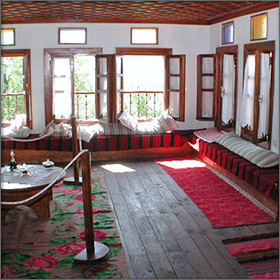
At the centre of Theologos, the old capital of the island, one can find a traditional folklore museum. It is set in the well preserved Manor Hatzigiorgi and is thematically divided into two floors.
On the ground floor and surrounding area are various tools for everyday use by different professionals of the island including farmers, sheep herders, fishermen, carpenters etc.
On the second floor, the rooms are designed to represent a typically traditional Thassian house of the past. There is the small table near the fireplace where guests would be seated as well as other traditional Thassian furniture items. The couple's bedroom shows a bed, chest with woven clothes, and woolen bed covers. The last room on the second floor is dedicated to the art of the house and a local cloth-making machine complete with traditional cloth and other tools.
Traditional Thassian House
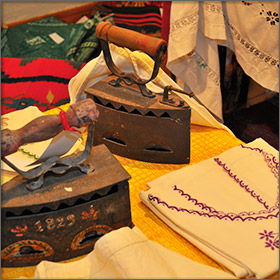
Inside the Kalogeriko building, situated at the old port of Limenas, is a reproduction of a traditional Thassian house offering visitors an inside look into everyday life and local customs from years past.
The house consists of living quarters, work spaces and a kitchen, all equipped with old tools, furniture and clothing that have been donated by locals from around the island.
Limenaria
The traditional folklore museum of Limenaria is home to various traditional Thassian clothes, farming and household tools, old photographs, and various ceramic pottery items from everyday life. The exhibits are ideal for visitors wishing to get a glimpse of life from a different era.
Kallirachi
The folklore museum of Kallirachi is located in the centre of the village square in a recently renovated manor originally built in 1880. There you can see furniture and items of another traditional Thassian house.
A new section has recently been added with personal items belonging to past sailors. Sailing and fishing were the main occupations of residents from this village, and Kallirachi boasts having the highest number of experienced sailors of the island.
Arts Museums
Polygnotos Vagis
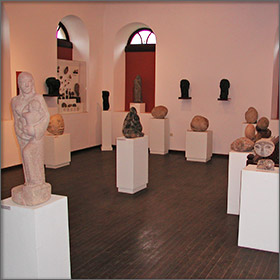
This museum is located in the village of Potamia, the birthplace of the sculptor Polygnotos Vagis. It's housed in a stone building constructed during the 20th century and hosts many of his wonderful pieces of art.
Walking into the museum you'll notice the artist's work is the center of attention, surrounded by a simple interior and high windows that give a nostalgic tone. Every museum has its own story to tell and the story of Vagis focuses on the nature and wildlife of Greece such as birds, fish, and starry skies in shining moonlight.
In 1911, at seventeen years old, Vagis left Turkish occupied Greece to live as an immigrant in the USA. There he fought for both his survival and his passion for sculpting, instilled at a young age by his father who was a wood sculptor. He experienced great difficulties as a young, inexperienced, and illiterate immigrant, but he overcame them and was accepted into the renowned Baux Art Institute of New York, where he studied the art of sculpting. His talent amazed many people and he became well-known among great artists of expressionism.
In 1965, he died alone, without any family members from Greece by his side, in a hospital of expats in New York. During his entire life, however, his heart never stopped beating for his country, to whom he left his entire personal collection of his own art. This collection is displayed for everyone to see in the museum.
Many great works of Vagis can also be found on display in museums throughout the United States.
Agriculture Museums
Traditional Olive Mill

A real gem of the island is the traditional olive mill located in the mountain village of Panagia. It gets its energy from water that flows through the village from the mountain springs, and for many generations it was used by the Sotirelis family to press olives and produce oil. Although it no longer operates commercially, due to modern and more efficient facilities that are available on the island today, visitors are warmly invited to see it.
The watermill is a wonderful symbol of the island's old traditions. It represents one of Thassos' most important industries and demonstrates the excellent techniques Thassians used to take advantage of their natural environment in a safe and responsible way. When activated, the watermill diverts the water flow from the village's three springs so that it passes through the mill, powering all of the machinery that was used ever since 1915 to produce olive oil in the village. Today, it is the last watermill of its kind that still works in all of Greece.
By visiting this treasure of local tradition, one can watch how the whole process of producing olive oil was done before electricity was available on the island. The Sotirelis family offers an exhibition of rich photographic and video content, providing a unique opportunity to learn about every stage of the process, from olive harvesting all the way to bottling the oil. You can also sample and buy the olive oil that the family produces today!
Olive Oil Museum
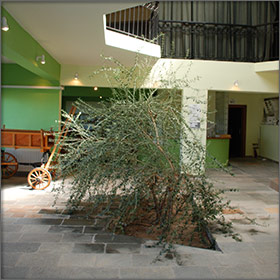
The Olive Oil Museum gives you a chance to learn about the modern production process of olive oil as well as its incredible history. It houses a wonderful exhibit that shows how olives have been pressed to produce oil throughout the centuries, and explains how olive oil has become such an important and integrated part of Greek culture.
The museum offers a rich exhibition of photographs which include, among other things, many varieties of olives, different methods of extracting oil over the last 6,000 years, the historical influence of olives on Greek culture and art, and the close relationship between olive oil production and Greece's economy.
There is also a screening room where you can sit and watch a video about the fascinating history of olives.
Perhaps the most interesting exhibit is where you can try a variety of olive products and compare their different qualities and taste. You'll then have the option to buy some to take back home to enjoy.
Don't forget to tour the museum's fascinating outdoor exhibition of 40 local and exotic types of olive trees, a significant accomplishment when you consider that the total known types around the world is 163.
Also worth mentioning is that during construction work in the museum's courtyard, 16 ancient storage jars (pitheonas) used for general storage were found. The mill owners are optimistic that they will discover more clues that will help explain what was built on the grounds of the museum much earlier... possibly a homestead, an oil mill, or a wine-press.
The Olive Oil Museum was established by the private initiative Organic Olive Mills of Thassos. It is located near the ring road of Thassos between the villages of Skala Prinos and Skala Rachoni.
Honey Factory
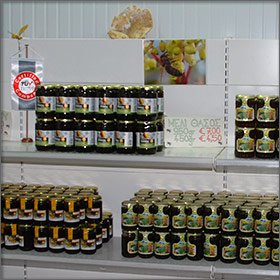
Established by the Beekeeping Cooperative of Thassos, this is where over 100 beekeepers from around the island come together to standardise and market their honey products for selling and export.
The Honey Factory is an excellent place to visit for sweet and delicious locally-produced honey as well as various other products made from Thassian honey and beeswax.
Try all six types of honey that are produced on the island: flowers, pine, heather, chestnut, thyme, and a distinct variety from Thassos.
You can also try honey straight from the comb and buy traditionally-produced honey products like propolis, royal jelly, and pollen.
You'll also find a wide selection of candles made from Thassian beeswax as well as traditional sweets made of honey, such as one called 'Karydomelo' that is made of walnuts and honey.
If you're on Thassos around the 15th of August, don't miss the annual Honey Festival which is held on the grounds of the Honey Factory. It's a remarkable event where you can enjoy a tasty feast, traditional dancing, and the unique opportunity to sample all kinds of Thassian honey products.
The Honey Factory is located near the ring road of Thassos between the villages of Skala Prinos and Skala Rachoni.

